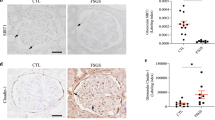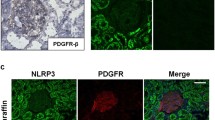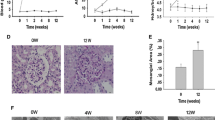Abstract
Semaphorin 3A (sema3A) was recently identified as an early diagnostic biomarker of acute kidney injury. However, its role as a biomarker and/or mediator of chronic kidney disease (CKD) related to diabetic nephropathy is unknown. We examined the expression of sema3A in diabetic animal models and in humans and tested whether sema3A plays a pathogenic role in the development of diabetic nephropathy. The expression of sema3A was localized to podocytes and epithelial cells in distal tubules and collecting ducts in control animals, and its expression was increased following the induction of diabetes. Quantification of sema3A urinary excretion in three different diabetic mouse models showed that excretion was increased as early as 2 weeks after the induction of diabetes and increased over time, in conjunction with the development of nephropathy. Consistent with the mouse data, increased sema3A urinary excretion was detected in diabetic patients with albuminuria, particularly in those with macroalbuminuria. Genetic ablation of sema3A or pharmacological inhibition with a novel sema3A inhibitory peptide was protected against diabetes-induced albuminuria, kidney fibrosis, inflammation, oxidative stress, and renal dysfunction. We conclude that sema3A is both a biomarker and a mediator of diabetic kidney disease and could be a promising therapeutic target in diabetic nephropathy.
Key messages
-
Diabetes induced sema3A excretion in urine.
-
Increased semaphorin 3A was associated with severity of albuminuria.
-
Seme3A-mediated diabetes induced glomerulosclerosis.
-
Peptide-based inhibition of semaphorin3A suppressed diabetic nephropathy.






Similar content being viewed by others
References
Rossing P, de Zeeuw D (2011) Need for better diabetes treatment for improved renal outcome. Kidney Int Suppl 79:S28–S32
Rosolowsky ET, Skupien J, Smiles AM, Niewczas M, Roshan B, Stanton R, Eckfeldt JH, Warram JH, Krolewski AS (2011) Risk for ESRD in type 1 diabetes remains high despite renoprotection. J Am Soc Nephrol 22:545–553
Hostetter TH (2001) Prevention of end-stage renal disease due to type 2 diabetes. N Engl J Med 345:910–912
Roth L, Koncina E, Satkauskas S, Cremel G, Aunis D, Bagnard D (2009) The many faces of semaphorins: from development to pathology. Cell Mol Life Sci 66:649–666
Kumanogoh A, Kikutani H (2003) Immune semaphorins: a new area of semaphorin research. J Cell Sci 116:3463–3470
Bielenberg DR, Klagsbrun M (2007) Targeting endothelial and tumor cells with semaphorins. Cancer Metastasis Rev 26:421–431
Tufro A, Teichman J, Woda C, Villegas G (2008) Semaphorin3a inhibits ureteric bud branching morphogenesis. Mech Dev 125:558–568
Behar O, Golden JA, Mashimo H, Schoen FJ, Fishman MC (1996) Semaphorin III is needed for normal patterning and growth of nerves, bones and heart. Nature 383:525–528
Kolodkin AL, Levengood DV, Rowe EG, Tai YT, Giger RJ, Ginty DD (1997) Neuropilin is a semaphorin III receptor. Cell 90:753–762
He Z, Tessier-Lavigne M (1997) Neuropilin is a receptor for the axonal chemorepellent Semaphorin III. Cell 90:739–751
Villegas G, Tufro A (2002) Ontogeny of semaphorins 3A and 3 F and their receptors neuropilins 1 and 2 in the kidney. Mech Dev 119(Suppl 1):S149–S153
Robert B, Zhao X, Abrahamson DR (2000) Coexpression of neuropilin-1, Flk1, and VEGF(164) in developing and mature mouse kidney glomeruli. Am J Physiol Renal Physiol 279:F275–F282
Reeves WB, Kwon O, Ramesh G (2008) Netrin-1 and kidney injury. II. Netrin-1 is an early biomarker of acute kidney injury. Am J Physiol Renal Physiol 294:F731–F738
Ramesh G, Krawczeski CD, Woo JG, Wang Y, Devarajan P (2010) Urinary netrin-1 is an early predictive biomarker of acute kidney injury after cardiac surgery. Clin J Am Soc Nephrol 5:395–401
Jayakumar C, Ranganathan P, Devarajan P, Krawczeski CD, Looney S, Ramesh G (2013) Semaphorin 3A is a new early diagnostic biomarker of experimental and pediatric acute kidney injury. PLoS ONE 8:e58446
Morris SM, Gao T, Cooper TK, Kepka-Lenhart D, Awad AS (2011) Arginase-2 mediates diabetic renal injury. Diabetes 60:3015–3022
Breyer MD, Bottinger E, Brosius FC, Coffman TM, Harris RC, Heilig CW, Sharma K, for the AMDCC (2005) Mouse models of diabetic nephropathy. J Am Soc Nephrol 16:27–45
Brosius FC, Alpers CE, Bottinger EP, Breyer MD, Coffman TM, Gurley SB, Harris RC, Kakoki M, Kretzler M, Leiter EH et al (2009) Mouse models of diabetic nephropathy. J Am Soc Nephrol 20:2503–2512
Williams G, Eickholt BJ, Maison P, Prinjha R, Walsh FS, Doherty P (2005) A complementary peptide approach applied to the design of novel semaphorin/neuropilin antagonists. J Neurochem 92:1180–1190
Ramesh G, Reeves WB (2005) p38 MAP kinase inhibition ameliorates cisplatin nephrotoxicity in mice. Am J Physiol Renal Physiol 289:F166–F174
Tak E, Ridyard D, Badulak A, Giebler A, Shabeka U, Werner T, Clambey E, Moldovan R, Zimmerman M, Eltzschig H et al (2013) Protective role for netrin-1 during diabetic nephropathy. J Mol Med 91:1071–1080
Zhang H, Schin M, Saha J, Burke K, Holzman LB, Filipiak W, Saunders T, Xiang M, Heilig CW, Brosius FC III (2010) Podocyte-specific overexpression of GLUT1 surprisingly reduces mesangial matrix expansion in diabetic nephropathy in mice. Am J Physiol Renal Physiol 299:F91–F98
Nauta FL, Boertien WE, Bakker SJL, van Goor H, van Oeveren W, de Jong PE, Bilo H, Gansevoort RT (2011) Glomerular and tubular damage markers are elevated in patients with diabetes. Diabetes Care 34:975–981
Tapia R, Guan F, Gershin I, Teichman J, Villegas G, Tufro A (2007) Semaphorin3a disrupts podocyte foot processes causing acute proteinuria. Kidney Int 73:733–740
Whiting DR, Guariguata L, Weil C, Shaw J (2011) IDF Diabetes Atlas: Global estimates of the prevalence of diabetes for 2011 and 2030. Diabetes Res Clin Pract 94:311–321
Yebra M, Montgomery AMP, Diaferia GR, Kaido T, Silletti S, Perez B, Just ML, Hildbrand S, Hurford R, Florkiewicz E et al (2003) Recognition of the neural chemoattractant netrin-1 by integrins [alpha]6[beta]4 and [alpha]3[beta]1 regulates epithelial cell adhesion and migration. Dev Cell 5:695–707
Wen H, Lei Y, Eun SY, Ting Y (2010) Plexin-A4-semaphorin 3A signaling is required for Toll-like receptor 4 and sepsis-induced cytokine storm. J Exp Med 207:2943–2957
Author contributions
RM and PR researched the data and wrote the manuscript. CJ researched the data and reviewed and edited the manuscript. FN researched the data and reviewed and edited the manuscript. RTN reviewed and edited the manuscript. MB and NLW reviewed and edited the manuscript. GR wrote manuscript and edited the manuscript.
Funding
This work was supported by an R01grant (1R01DK083379-01A6) to Ganesan Ramesh from NIH-NIDDK. PR and RM are recipients of American Heart Association Postdoctoral fellowship.
Conflict of interest statement
The results presented in this paper have not been published previously in whole or part. All authors declared that they have no conflict of interest related to this study.
Author information
Authors and Affiliations
Corresponding author
Additional information
Riyaz Mohamed and Punithavathi Ranganathan equally contributed to this work.
Electronic supplementary material
Below is the link to the electronic supplementary material.
ESM 1
(PDF 551 kb)
Rights and permissions
About this article
Cite this article
Mohamed, R., Ranganathan, P., Jayakumar, C. et al. Urinary semaphorin 3A correlates with diabetic proteinuria and mediates diabetic nephropathy and associated inflammation in mice. J Mol Med 92, 1245–1256 (2014). https://doi.org/10.1007/s00109-014-1209-3
Received:
Revised:
Accepted:
Published:
Issue Date:
DOI: https://doi.org/10.1007/s00109-014-1209-3




